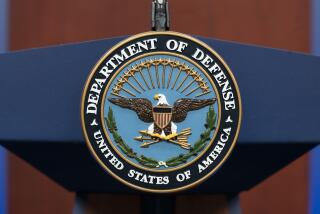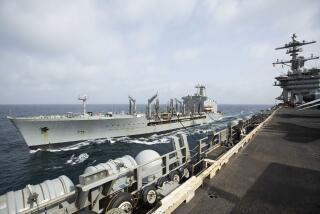Navy Sends More Ships Into Gulf : Military: An 8-vessel battle group arrives, with the carrier Midway and escorts on the way.
- Share via
WASHINGTON — An eight-ship amphibious battle group entered the Persian Gulf on Thursday and a carrier task force was set to join it within days as the U.S. military intensified its preparations for combat in the volatile region.
The battle group, with about 10,000 Marines and sailors aboard, steamed into the gulf to “conduct routine operations,” according to military authorities. The aircraft carrier Midway and its escort ships also will enter the gulf in the next few days in a highly visible symbol of U.S. readiness for war as Tuesday’s deadline for Iraqi withdrawal from Kuwait looms.
Meanwhile, the Pentagon confirmed that it has placed a rush order for 16,099 rubberized body bags, or “human remains pouches,” for shipment to Saudi Arabia. Pentagon spokesman Pete Williams said that the body bags are being sent to replace lighter-weight nylon cases already in the region.
He insisted, however, that the size of the order is not related to military estimates of the number of casualties that would be suffered in a war with Iraq. The Defense Department has classified all information about casualty estimates, hospital capacities and the number of personnel dedicated to processing war dead.
Williams said that the number of body bags ordered is determined by a computer program that takes into account the size of the force deployed, the possibility of civilian casualties, unrelated deaths from disease or accidents and other factors.
Williams also said that the Pentagon could find no support for a report issued by the military in Saudi Arabia earlier this week that six Iraqi helicopters had defected and landed in Saudi Arabia near the Kuwaiti border.
“The Department of Defense can find nothing to confirm those reports and does not believe them to be true,” Williams said. He said that the story originated with a single Marine stationed near the Kuwait border who heard helicopter activity Monday night, and it unaccountably mushroomed into the tale of the defecting choppers.
Williams said that the number of U.S. troops in the region has grown to 370,000 soldiers, sailors, airmen and Marines, up 10,000 since Tuesday.
The deployment of the additional ships brings to 26 the number of U.S. naval craft in the Persian Gulf, including 10 ships in an amphibious warfare task force. Another 13 U.S. warships are in the northern Arabian Sea, 12 are in the Red Sea and 29 are in the Mediterranean.
Five aircraft carriers currently are in the region. A sixth, the San Diego-based Ranger, is in the Indian Ocean approaching the Gulf of Oman just outside the Persian Gulf. The six carriers carry about 450 aircraft, including fighters, bombers and surveillance planes.
In addition, an 18-ship amphibious task force bearing an estimated 11,000 Marines is en route to the region and will be on station within the next several days, officials in Saudi Arabia said.
In all, the 36 ships there to support a Marine amphibious assault will create the largest seaborne landing force since the Korean War.
While Iraq has virtually no navy to challenge U.S. seapower, at least nine naval mines have been found floating in the gulf in the last 10 days, posing a danger to allied ships. It has not yet been determined who laid them, but officials believe that most or all were left over from the eight-year Iran-Iraq War, which ended in 1988.
Meanwhile, Gen. Colin L. Powell, chairman of the Joint Chiefs of Staff, said in a speech to a lawyers’ group that Iraqi President Saddam Hussein has perpetrated the “rape” of Kuwait and asked: “How can we not be compelled to action?”
Staff writer Douglas Jehl in Saudi Arabia contributed to this report.
More to Read
Sign up for Essential California
The most important California stories and recommendations in your inbox every morning.
You may occasionally receive promotional content from the Los Angeles Times.










